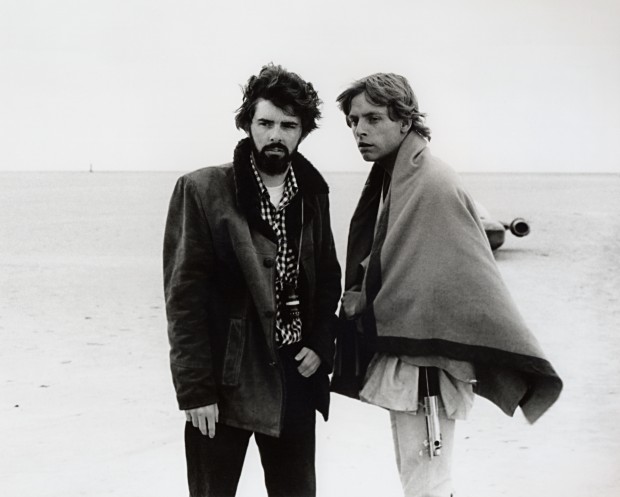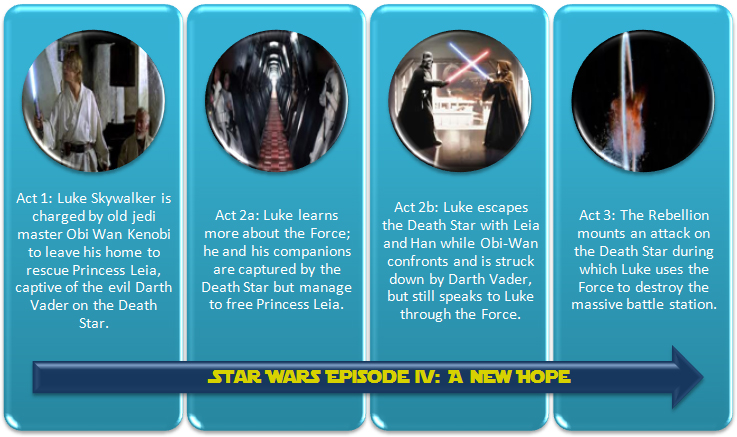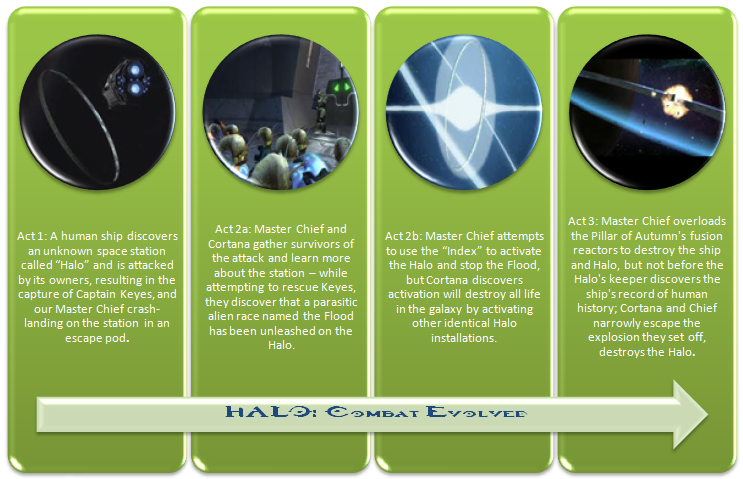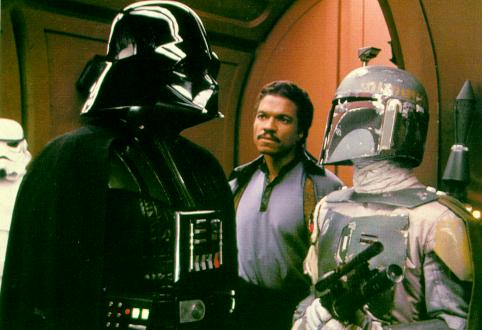TRILOGY BUILDING Part I: Story Mapping the Star Wars and Halo trilogies
Some of you may remember a video I made back in 2008 talking about the concept of “Trilogy Building” and the connections between one entry in a trilogy and the trilogy as a whole. In terms of story mapping, it’s basically using the Story Maps beat sheet to break down a trilogy as if it were one movie narrative. My buddy James Robert Martin and I originally developed this material with the Star Wars and Lord of the Rings movie universes, but we eventually made the decision to sideline Rings in favor of Halo, to acknowledge the increasing importance of story in games. We believe that this analysis can be used to construct a trilogy of screenplays, books or video games, depending on your interest.
James is here for an exclusive guest blog series that contrasts and compares the most popular movie series in history with the most popular video game in history. Enjoy.
Story Mapping the Halo-verse
by James Martin
Part I: The structure of a trilogy
Crafting a good story is, like any art form, more than just a matter of coloring inside the lines and making sure everything is in its place. In fact, the best artists, photographers, and storytellers are able to composite their respective images in such a way that the viewer or reader isn’t even aware that a “form” is being followed.
When we talk about a “map” or “structure” for a story, we’re not referring to a formulaic, predictable series of events, but rather a framework on which any story can be comfortably draped. In Dan’s Story Maps method, the plot points we all struggle for in our writing have clearly defined beats that work for any story, even ones in the interactive medium. What’s even more surprising is, trilogies follow the same pattern.
In the film medium, trilogies have always been out there, but only recently has this trend been so widespread in electronic media. Now more than ever, the art of storytelling is one of the central pillars to a successful video game franchise, almost as much as it is central to a film franchise. Now, whether you don’t live in L.A., don’t have the right contacts, or simply haven’t gotten the right break yet, writers can make sure that improper pacing of a story is not holding them back. As we prepare for the advent of a new trilogy in the Halo universe (Halo 4) let’s take a look back at the story crafted for the original Halo trilogy and see how it lines up with an iconic film trilogy, the classic Star Wars trilogy.
For those of you who are arriving late to the party, let’s start with some background information. The Halo saga tells the story of Master Chief, a super soldier pressed into action against a new threat to humanity, an alien race known as The Covenant. In the first installment, a colony ship called the Pillar of Autumn encounters the enemy force near a mysterious installation which we learn to be the titular Halo device.
Already parallels can be drawn between Halo and Star Wars: Episode IV with the existence of a super weapon (Halo/Death Star) as well as a “Hero of Mankind” (Master Chief/Luke Skywalker) and a menacing group of antagonists (The Covenant/The Empire.) Notice how certain elements are revealed and the same point in each saga. Very early on in each story, we are introduced to our protagonist, and the existence of an ominous device. In the case of Halo, our heroes are fleeing to the ring shaped “space station” which later turns out to be a superweapon. In Episode IV, Luke discovers a message from a stranger which, in full length, reveals the existence of the Empire’s superweapon. That’s no moon… it’s a space station! No, wait, it might be a moon… that blows everything up!
Now, in any story, your opening is key. A strong hook is what captures the interest of your viewer. For Halo, the action begins from the first scene, an opening in which the Pillar of Autumn is under fire from Covenant forces and fleeing to a then-unknown ring-shaped “space station.” This hook serves equally well for the first installment of the trilogy as well as the trilogy as a whole. By the time our Inciting Incident rolls around, we have a raging conflict and a gauntlet being thrown down by Keyes in the form of attempting to escape the attacking force, as well as attempting to hide the existence of humanity.
Likewise, in Episode IV, we are immediately hooked by the image of a massive ship crawling onto the screen, being fired upon by an even larger ship from behind. They are moving towards a mysterious, dead-looking planet, and inside the ships are two droids, one of whom is carrying a message left by another inhabitant of the ship. At this point, much is unclear, but our interest is hooked by each of these pieces of the puzzle, and each piece plays an important part in the unfolding of the saga.
The important thing to remember, here, is that without these events, the trilogies would have started on a very weak footing. If, say, the Pillar of Autumn were just a colony ship floating through space which accidentally stumbled onto Halo, the story would lack conflict and urgency. The crew would have neither the immediate need for self-preservation nor the long-term dire need of protecting humanity itself. It would just be a story about some intergalactic travelers that, for all they knew, had just discovered some giant’s wedding band. In Episode IV, if the consular ship had not been being attacked in that exact location, our droids would not have been able to escape to the planet which was home to both Obi Wan and our main protagonist. Or, if the attack hadn’t taken place at all, then events would be very anticlimactic at this point – Leia would make landfall, find Ben, and give him the message in person. No excitement. No hook.
Now, having successfully set up the first installment and the trilogy itself (albeit unbeknownst to the player/viewer) there’s a lot left to accomplish in the first leg of a trilogy. Much like act one of a single film, film one of a trilogy must establish the first major conflicts, the major players, basically, everything that sets in motion what is to come. Often we reach the end of the first entry in a film series and don’t have much of an indication that more is to come. In retrospect, however, it becomes more obvious. Sure, the original Star Wars had a “happy” conclusion with the destruction of the Death Star, but there was so much unresolved, and it was set up perfectly by the trilogy’s first “act,” if you will.
The first pillar in the Halo trilogy includes our introduction to the Covenant and the Human forces, an alien race known as “The Flood” which is a threat to all life in the universe, the titular Halo device, which at first is seen as a means of destroying the flood, but later is learned is connected to multiple other Halo devices which will actually wipe out all life, and an unassuming gatekeeper, 343 Guilty Spark who, for better or worse, is the caretaker of the Halo itself.
By the end of this episode, the singular goal of preventing the destruction of all life in the universe is achieved by Cortana and Chief overloading the engines of the Pillar of Autumn. However, this isn’t a resolution to all problems in the plot. The Covenant still exists. The plot to destroy humanity hasn’t been addressed. Perhaps most importantly, the existence of 6 other Haloes is still looming over the heads of our heroes.
 “Dan has created a book that is straightforward and full of valuable insight and guidance for screenwriters at different experience levels.”
“Dan has created a book that is straightforward and full of valuable insight and guidance for screenwriters at different experience levels.”
-Laurie Lamson, Editor, Now Write! Screenwriting
Also true with Episode IV: we are introduced to the Empire and a plucky Rebellion, as well as the Death Star – the weapon to end all weapons, which will surely be used to threaten the entire galaxy into falling in line with the Empire. Our primary antagonist, Darth Vader, serves to drive the conflict forward as the foil to Obi Wan and the destabilizing influence on Luke. However, despite the success in destroying the Death Star at the end of this episode, we are left with many unanswered questions – The Empire still exists, and the Rebellion is more a target than ever. Obi Wan, while dead, was still able to communicate with Luke. Perhaps most importantly – our main antagonist, Darth Vader, was only temporarily “handled” when Han sent him spiraling out of control into space. What’s next?
The Trilogy-to-single-film comparison is seen even more clearly when we examine the breakdown of the classic 3/4-act structure. In a single film, the midpoint should fall in the middle of act two, so by extrapolation, the middle of film or game two should be the midpoint of the trilogy structure (so, we look at each film or game as a single act in the overall trilogy, even though each has its own full structure by itself.) In the Act 2a break, things should be reaching a “rock bottom” point for the protagonists. Troubles are piling up, and solutions seem few and far between. This should be evident at the midpoint of each individual installment in the trilogy, and the midpoint of the SECOND installment should be the true low point for the trilogy as a whole. (This is why the second episode of many film and game series have a darker bent to them – by the end of Act 2, things are still up in the air, the “bad guys” still seem to have the upper hand, and the story is gathering its breath before plunging into the climactic finale.)
In the middle of Halo, we see the release of The Flood, which comes to be one of the central conflicts in the entire trilogy. Shortly thereafter, Cortana discovers a plot buried in the ring’s computer system to destroy humanity. Talk about a low point for our heroes!
For Episode IV, the midpoint comes when Obi Wan is killed by Darth Vader. This is the real low point of this film, because it completely knocks our protagonist off-balance. It is up to Han and Leia to refocus him on the immediate goal of escaping with Leia.
At the Act 2a break of Halo 3, Gravemind has betrayed our protagonists upon the death of the Prophet of Truth, and the Ark is fabricating a new replacement Halo to carry out the extinction event.
For Episode VI (Return of the Jedi) the low point occurs when Luke allows himself to be captured by Darth Vader (and by proxy, the Emperor.) Hope appears to be slim for our protagonists at this point.
There is a reason I skipped talking about Halo 2 and Episode V (Empire Strikes Back) until now – let’s talk about that now. The midpoint of each saga serves a dual purpose. It is the low point of the episode, but it is also the fulcrum on which pivots the foundation of the entire trilogy. For Halo 2, our midpoint comes when the Prophet of Regret sends the distress call summoning the entire Covenant fleet to the new Halo. This allows for several things to happen without which the rest of the trilogy simply wouldn’t exist. First, it brings the full weight of humanity’s plight down on the heads of our protagonists – you now have the entire fleet of an alien race bent on your destruction zeroing in on your location, increasing the urgency of Episode 2, and driving forward the trilogy storyline. Also, this presents the perfect opportunity for our two lead protagonists from both sides (Chief and The Arbiter) to eventually meet. These two characters achieve together what would likely be impossible on their own, because they each bring unique skillsets and knowledge to the arrangement. When the Prophet of Regret is killed, the arriving Covenant are thrown into turmoil and start a quasi civil war amongst themselves. Amid the turmoil, a new wrinkle is free to reveal itself in the form of Gravemind. The hive mind of the flood, Gravemind plays an integral part in the rest of the trilogy, as does the destruction (or perhaps not) of the flood itself, which is necessary for success in Chief’s dual goals of preventing the destruction of humanity and saving all life in the universe.
For Episode V, things appear just as grim. Our heroes seek help from a charismatic friend of Han’s, only to be turned over to Darth Vader himself. Sensing that his friends are in trouble, Luke abandons his training early, against the warnings of Yoda that he could actually be doing more harm, even though he intends to help his friends. As in Halo 2, these events set in motion not just the events for the rest of this episode, but also for the rest of the trilogy. Again, there are more events taking place than can possibly be resolved within the confines of the rest of this single story, and so the events of the trilogy’s “third pillar” are set up perfectly. Luke has abandoned his training to take on a Sith Lord who ultimately reveals he is Luke’s father, Han is carted off in carbonite by a ruthless bounty hunter (Boba Fett), and Luke loses a hand to Vader before being rescued by Leia, Chewie, and Lando. Talk about loose ends!
In illustration of the point – FAR more happens in the midpoint of both stories than is actually resolved within the single episode itself. In fact, most of what happens drives forward the necessity of a third act, for the triumph of the protagonists.
This just scratches the surface of the story structure of the Halo and Star Wars trilogies, but hopefully gives you a very enlightening glimpse of how trilogies mirror the structure of their individual parts – each act and each beat serving as a building block of a larger story on top. The DNA of the story, if you will, creating and building a fractal chaos that dovetails together perfectly when the overall picture is viewed as a whole.
Go To: PART II: The Characters and Worlds of Star Wars and Halo
James Martin
thisspacereserved.blogspot.com
@jaymo1978
 “…as much as an analysis of Nolan the filmmaker as it is an analysis of story structure within his films.”
“…as much as an analysis of Nolan the filmmaker as it is an analysis of story structure within his films.”
-Script Magazine








Leave a Reply
Want to join the discussion?Feel free to contribute!